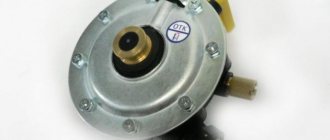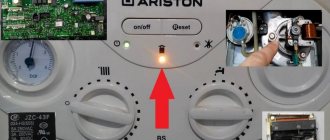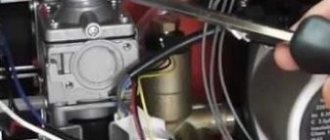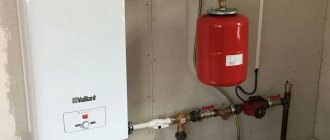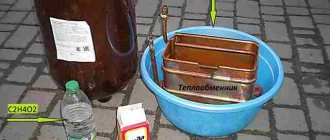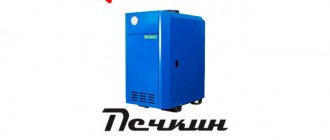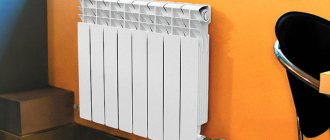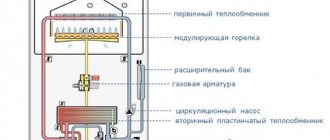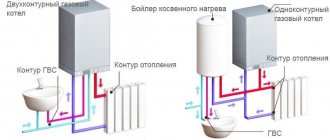10/24/201805/13/2021 Ivan Korabelnikov 1 Comment
For heating private houses, it is most profitable to use gas heating equipment. This is due to the fact that gas is still considered the cheapest type of fuel. Such equipment is safe, economical and efficient.
We present to your attention a rating of gas boilers based on reviews from consumers and experts. If you decide to install gas heating in your home, then a review of the devices presented below will help you navigate the variety of gas-fired boilers.
Rating of gas boilers for home
When selecting nominees, our team, made up of heat power engineers and simply experienced users, studied the operating features of boilers of various types and designs:
- Wall-mounted – compact models, attached to walls, can be used in city apartments as an addition to centralized heating;
- Floor-standing – installed on the floor in a separate room, more powerful than wall-mounted, noisier, the best option for a country house;
- Single-circuit - only for heating homes and offices.
- Double-circuit - for heating and supplying hot water (DHW).
- Non-volatile - not equipped with pumps and fans, can work in non-electrified rooms;
- Atmospheric - they work without forced ventilation, with natural exhaust of combustion products, burning oxygen from the room;
- Turbocharged - with forced air supply into the combustion chamber and exhaust of combustion products by a fan.
Comparing the strengths and weaknesses of several dozen units and analyzing customer reviews, a team of specialists from the Vyborexperta.ru website managed to select the 15 best models, dividing them into 4 sub-ratings.
The best single-circuit wall-mounted gas boilers
Small and lightweight devices. They don't take up much space. They are used in apartments and private houses. Most models are equipped with pumps, a full set of temperature sensors, and expansion tanks. You can monitor the condition of any product and adjust its settings remotely. It is enough to equip it with a thermostat with a GSM module.
Baxi Luna-31.310 Fi
Product from an Italian brand. With a power of 31 kW, it can easily cope with heating rooms with a total area of up to 310 m2. Equipped with modern electronics with the function of self-diagnosis and programming of the device’s operation by day of the week. The copper heat exchanger perfectly transfers heat from the gas burner to water. The diameter of the chimney hole is 100 mm.
The boiler runs on natural gas, and in the absence of a centralized supply - on bottled propane. Economical fuel consumption is ensured by the flame modulation function. The control unit with an informative LCD display ensures heating of heating water and maintaining the temperature in the range from 30 to 85°C. Coolant circulation is maintained by a built-in pump. Excess water is stored in a built-in 10 liter expansion tank.
Product dimensions: 763x450x345 mm, weight - 40 kg. The diameter of the supply and return pipes is 3/4 inch (DN 20mm). The circuit pressure is maintained at 3 bar. The maximum gas flow is 3.52 m3/hour. Protection against freezing and overheating, pump blocking, auto-ignition, and gas control systems are responsible for safety. It is possible to connect external objects to the control unit: circulation pump, boiler, shut-off and control valve drives.
Advantages:
- Weather-compensated automation;
- Flame modulation function;
- Copper heat exchanger;
- Gas control.
Flaws:
- High price.
Buderus Logamax U072-24
Developed by German engineers specifically for our conditions of unstable gas supply and voltage, hard water. With a thermal power of 24 kW it will create comfortable living conditions in a house of 240 m2. A burner with pre-mixing of air ensures complete combustion of fuel, the maximum consumption of which does not exceed 2.8 m3/hour. Savings are facilitated by flame modulation, automatic ignition, automatic control of water and exhaust gas temperatures.
The water temperature in the heating circuit is maintained in the range from 40 to 82°C. The unit is turbocharged. The built-in fan provides air supply to the closed combustion chamber and good exhaust through a coaxial chimney with a diameter of 60/100 mm.
Dimensions: 400x700x299, weight – 30 kg. The diameters of the direct and return heating and natural gas pipelines are 3/4 inches. The maximum water pressure does not exceed 3 bar. At the bottom of the case there is a simple and clear control panel with an LCD display, which displays the current values of the controlled parameters.
Advantages:
- Compact and lightweight;
- The copper heat exchanger is not subject to corrosion and transfers heat well;
- Safe, equipped with many protection systems;
- Easy to operate;
- Energy efficient and economical due to pre-mixing of gas and air;
- It is possible to connect an external boiler.
Flaws:
- Not identified.
Coaxiality is the coincidence of the axes. In our case, this is a pipe-in-pipe type structure, where both pipes have the same axis. Coaxial chimneys are used to simultaneously supply air into the combustion chamber through the gap between the pipes and remove combustion products through the inner pipe.
Protherm Panther 25 KTO
In our review, a Slovak turbocharged device with a power of 25 kW, designed to heat 250 m2 of area. It is easy to operate, takes up little space, operates with high efficiency (92.8%) and is affordable. Its gas and water “filling” is housed in a steel rectangular body 400 mm wide, 800 mm high and 338 mm deep. The entire structure weighs 41 kg.
In the absence of a centralized gas supply, it is easily converted to power from liquefied gas. The combustion chamber is closed type. Coolant circulation is maintained by a built-in pump. The expansion tank holds 10 liters of water. Automation maintains water temperature in the range from 35 to 85°C, with a maximum pressure of up to 3 bar. The gas is connected to a pipe with a diameter of 1/2 inch, the forward and return pipelines of the heating circuit are connected to pipes with a diameter of 3/4 inch.
Temperature control in pipes and chimneys is provided by temperature sensors. Instrument readings are displayed on the LCD display of the control panel. The device is equipped with weather-dependent automatic control. The sound load from a working boiler does not exceed 36 dB, i.e. roughly equivalent to the noise of a muffled conversation.
Advantages:
- Compact and lightweight;
- Easy to install;
- Turbocharged;
- Easy to control;
- Economical, with weather-dependent automatic control and flame modulation.
Flaws:
- Not identified.
Bosch Gaz 6000 W WBN 6000
Works stably even with unstable gas pressure, water pressure, and voltage fluctuations in the AC network. With a power of 18 kW, it is suitable for installation in apartments and small country cottages with an area of up to 200 m2. Automation maintains the temperature in the circuit within 40-80°C.
Dimensions are small: 400x700x300mm, weight - 28 kg. A control panel with an LCD display is mounted in the lower part of the case, which displays settings and temperature sensor readings. In the event of an emergency stop of the boiler, an error code is displayed on the display, which determines the malfunction.
Bosch Gaz 6000 W WBN 6000 – 18 H is equipped with a copper heat exchanger, modulated fan, safety valve. Security systems include gas control and electric ignition. The housing is protected from overheating by additional thermal insulation. Efficiency 93%, maximum gas flow 2.1 m3/hour.
Advantages:
- Small size and light weight;
- Management is simple;
- Economical;
- Ensures complete combustion of fuel;
- The concentration of harmful substances in flue gases does not exceed standard values.
Flaws:
- Not identified.
Operating principle
The operating principle of a single-circuit gas boiler is based on flow-through heating of the coolant using a gas burner.
The liquid that has cooled during circulation enters the boiler, where it is immediately sent to the heat exchanger . Passing through it, it receives the maximum possible heating for the current operating mode.
The coolant then flows into a three-way valve, where it is partially mixed with colder liquid from the return flow. This procedure allows you to achieve the set temperature and provide heating mode.
The prepared coolant is again sent to the heating circuit to undergo the next cycle.
The best single-circuit floor-standing gas boilers
The distinctive features of these units are ease of installation, high power, which allows you to confidently heat large country houses, and stable operation of the equipment, since it is easier for control systems to maintain the specified parameters of one circuit. In addition, they are cheaper than their dual-circuit “brothers”. After comparing the technical characteristics, our team selected the top four nominees that received the best user reviews.
Siberia 17
Domestic device with automatic equipment from an Italian manufacturer. It is distinguished by its extreme simplicity of design and control. Our manufacturers deliberately simplify their devices in comparison with foreign models. In their opinion, many monitoring systems and advanced functionality, often not fully in demand, lead to an increase in the cost of the boiler and reduce its reliability.
Siberia 17, with its thermal power of 17.4 kW, heats up to 170 m2 of space.
Management - mechanics. The heat exchanger is made of stainless steel, 2.0 mm thick. The unit is non-volatile and can operate in non-electrified houses. Maximum water temperature 90°C, at a pressure of 10 bar. The steel body of the device is covered from the inside with heat-insulating materials. Its dimensions: 280x850x560mm. Total weight – 56 kg.
The diameter of the heating circuit connecting pipes is 2 inches. The diameter of the gas pipe is 3/4 inch. The protective functions are performed by the gas control system. Maximum fuel consumption does not exceed 1.76 m3h.
Advantages:
- Simple and reliable in operation;
- Silent;
- Heat exchanger made of stainless steel;
- Italian automatics;
- Non-volatile;
- Mechanical control.
Flaws:
- Unreliable piezo ignition.
Protherm Bear 40 Klom
Our review includes a boiler from a Slovak manufacturer. Conveniently laid out, stylish design, with easy setup. The control is automatic, weather-dependent, from an external temperature sensor (purchased separately). With a power of 38.5 kW, it heats rooms up to 390 m2.
Controlled by microprocessor, Kromschreder, Exacontrol or Exabis. The boiler is equipped with an atmospheric burner and natural exhaust gas exhaust. The designers have provided for the possibility of equipping this model with forced ventilation, with the installation of a draft control sensor and a thermostat in the room. These measures will provide additional gas savings.
The boiler has dimensions: 880x505x600 mm, weight - 130 kg. Exhaust gases are removed through a chimney with a diameter of 150 mm. The heat exchanger is cast iron, five-section, two-pass, protected from condensation. The water is heated to 85°C, with a pressure of 3 bar. Fuel consumption 4.1 m3/hour. The boiler automation regulates the temperature of the coolant.
Advantages:
- Weather-compensated automatic control;
- Heat exchanger made of cast iron;
- Possibility of organizing domestic hot water from an indirect heating boiler;
- Availability of a display with power-on indication.
Flaws:
- The thin iron of the case “creases” easily.
Ferroli Torino 25
One of the world leaders in the production of boiler equipment, the Italian concern Ferroli SpA is represented in our review by the Torino 25 model. Floor-standing, single-circuit, with a power of 25 kW, designed for heating premises with a total area of up to 250 m2, creating a coolant pressure in the circuit of up to 3 bar .
The water temperature is maintained in the range from 40 to 90 °C. Unit dimensions: 432x850x550 mm. Total weight – 79 kg. Heat exchanger material – stainless steel, 2 mm thick. The diameter of the boiler connection pipes with the supply and return pipelines is 1 ½ inches, the gas supply is ½ inch. Open combustion chamber. Exhaust gases are removed by natural draft through a chimney with a diameter of 140 mm. If necessary, you can convert the burner to run on liquefied gas. A set of special jets is purchased separately.
Advantages:
- Non-volatile;
- Economical;
- Steel, stainless heat exchanger;
- Simple mechanical control.
Flaws:
- There is no control panel display.
Buderus Logano G 234 WS-50
Single-circuit unit developed by engineers of the German company Buderus. All boiler elements are housed in a steel casing with dimensions 726x1119x740mm. The weight of the structure is 255 kg. The maximum boiler power is 50 kW. This is enough to heat a large country house with an area of up to 500 m2. The flame modulation function automatically changes the power of the unit in accordance with the room temperature. The maximum supply water temperature does not exceed 120°C.
Exhaust gas is removed by natural draft through a chimney with a diameter of 180 mm. cast iron heat exchanger. The diameters of the heating pipe connections are 1 ½ inches, the gas supply is ¾ inches. Automatic control is implemented on the basis of the Logatic 2000 or 4000 software product, developed by engineers specifically for their line of floor-standing boilers. The current parameters are displayed on the control unit display. Safety is ensured by gas control and automatic ignition
Advantages:
- Operates silently and reliably;
- Atmospheric burner, pre-mixing;
- Automatic weather-sensitive;
- Cast iron heat exchanger;
- Control of external equipment, boilers, circulation pump is available.
Flaws:
- The heavy weight creates difficulties during delivery and installation.
Determining the thermal power of the boiler
Surely you know the popular methods for calculating the thermal performance of equipment - by area or volume of heated premises. Allegedly, for a dwelling of 100 square meters a 10 kW boiler is taken, for a country house of 200 square meters. m – unit 20 kW.
It is better not to use these approximate methods, since specific conditions are not taken into account - the climate in the area of residence, the degree of thermal insulation of the building, and so on. We suggest using more accurate calculation methods:
- According to the specific heat load per square square of living space, taking into account the location of the room and the number of window openings.
- The same goes for the volume of premises.
- Full calculation using the SNiP formula, taking into account the thickness and thermal insulation of external building structures.
An example of calculating heat loss by area, taking into account the location of rooms and the number of window openings
Comment. All 3 methods are described in detail in a separate guide to calculating the heat load for heating a residential building.
Knowing the heat consumption for heating the cottage, we select a gas boiler based on power as follows:
- if you plan to use the unit only for heating, multiply the resulting figure by a safety factor of 1.2;
- the power of a 2-circuit heat generator providing 2 water draw-off points is best selected with a margin of 1.3-1.5;
- To work with an indirect heating boiler with a volume of 200-300 liters, you will need a gas single-circuit boiler with one and a half capacity reserve (multiply by a factor of 1.5).
Let's give an example. For heating a private home with an area of 100 square meters. m is calculated to require 9 kW of energy. The minimum power of a gas heater excluding DHW will be 9 x 1.2 = 10.8 kW, a double-circuit boiler - 9 x 1.3 = 11.7 kW. If you need to heat the storage tank, the unit’s performance increases to 9 x 1.5 = 13.5 kW. Next, we select the nearest higher-power model from the line of heaters - 12 and 15 kW, respectively.
The best double-circuit floor-standing gas boilers
Unlike single-circuit ones, they are designed for heating and supplying hot water. In accordance with their purpose, they are more powerful and have an expanded range of built-in equipment. Our experts carefully studied several options. Their power, parameters, materials, composition of built-in equipment, and control system capabilities were compared. As a result, we managed to select three nominees with the best user reviews.
Pechkin KSGV-20
Domestic device, power 20 kW. It is capable of heating an area of 200 m2. The body of the device is a water jacket into which a burner with a control unit is built. Flue gases are removed through a chimney at the top of the device. The burner operation is controlled by a thermostat. For this purpose, a handle with divisions is placed on the front side of the body.
Heating water is heated to 80 °C, with a maximum pressure of 1.5 bar. In the DHW circuit, a difference between incoming cold and hot water is maintained at 25 °C. This means that the water entering the heat exchanger, with a temperature of 20°C, enters the shower net at a temperature of 45°C. Hot water capacity – 5 l/min.
The boiler is completely energy-independent. The presence of built-in equipment - a circulation pump, a fan - is not provided. Mechanical control. Device body dimensions: 720x340x490mm, weight – 58kg. Like all domestic boilers, it is distinguished by its simplicity of design, reliability and long service life. Maximum fuel consumption is 2.45 m3/hour. Efficiency – 89%.
Advantages:
- Low gas consumption;
- Minimal emissions of harmful substances into the atmosphere;
- Simple and understandable controls for everyone;
- Works silently;
- Non-volatile;
- Inexpensive.
Flaws:
- Low hot water output.
ZHMZ AKGV – 23, 2-3 Universal H
In our review AKGV – 23, 2-3 Universal H, i.e. double-circuit, power 23 kW, Zhukovsky plant (Moscow region). Its entire cylindrical body is a tubular heat exchanger that heats water for heating. Inside it, in the upper half, there is a coil. This is the second heat exchanger for domestic hot water. The productivity of hot water at a temperature of 35°C is 7.1 l/min.
The automation is Italian, Euro Sit, hidden behind a protective casing on the front side of the device. It consists of a gas solenoid valve with an integrated thermostat. The latter is necessary for smooth adjustment of the device’s power in automatic mode (based on the temperature of the water in the heat exchanger). You can set the coolant temperature in the range from 50 to 90°C. As it heats up, the thermostat reduces the burner flame. When the set values are reached, the automation switches the burner to low-flame mode, and after some time turns it off.
Under the boiler cover there is a thermostat that turns off the burner when the water overheats above 90°C and a chimney draft sensor. To control the flame and stop the gas supply when the burner goes out, the automation is equipped with a thermocouple. To ensure safe operation of the gas part of the equipment, a gas control system is provided. Case dimensions: 420x1050x480 mm, weight - 60 kg. Gas consumption does not exceed 2.55 m3/hour.
Advantages:
- Simple device;
- Works without failures for many years;
- Italian automatics;
- Automatic adjustment of burner power;
- Low gas consumption.
Flaws:
- Low hot water output;
- Low DHW water temperature.
Lemax Premium-25B
The unit of the Lemax company from Taganrog, a leader among domestic manufacturers of boiler equipment. Floor-standing, double-circuit, power 25 kW. Steadily heats rooms with a total area of 250 m2. The heating water is heated to 90°C, the maximum pressure is 3 bar. DHW parameters: capacity – 7 l/min, pressure 6 bar. This is enough to deliver water to a height of up to 60 m.
There are no built-in pumps or fans. The ignition device is piezoelectric. The boiler does not require power supply and can be installed in non-electrified houses. Smoke removal is natural. For stable operation of the boiler, the vacuum in the chimney must be at least 4 and no more than 40 Pa. Hood diameter – 130 mm.
Case dimensions: 556x961x470mm, weight – 88 kg. The fittings for connecting the heating pipes (direct and return) have a diameter of 2 inches, the inlet and outlet of the hot water pipelines are ½ inch, the gas inlet is also half an inch. Multi-flame injection burner, manufactured by . Maximum fuel consumption – no more than 3 m3/hour. The automation was manufactured by the Italian concern “Sit”.
Advantages:
- Economical;
- Non-volatile;
- Italian automatics;
- High efficiency;
- Safe to use;
- Holds coolant temperature well.
Flaws:
- The piezo ignition element is unreliable.
How to choose a gas boiler for your home
The correct choice depends on the size of the heated premises, its efficiency (fuel consumption), and the presence of protective automation. The more of these protections, the safer the operation. Not the least role in the choice of equipment is played by its price, design features, number of circuits, and installation methods. Let's consider the main criteria.
Power
This parameter determines what the unit is capable of. Will it be able to “handle” the heating of a large house, or will it be enough for only two rooms in a city apartment. It has been established that each kilowatt of thermal power is capable of heating 10 m2 of space.
When choosing a boiler based on the area of your home or office, multiply its power by 10 and compare the result with the size of the heated room. It is necessary to take into account how insulated the house or apartment is, the tightness of window and door fillings. If the house has thin, paper-like walls, poor glazing and continuous drafts, it cannot be heated even with the most powerful apparatus.
Design
Wall-mounted gas boilers for heating small offices and city apartments are very convenient. They are more compact than floor-mounted ones. Most of them are equipped with built-in pumps, fans, and a variety of control systems. Floor-mounted ones differ from wall-mounted ones in their larger dimensions and significant weight, up to 300 kg. Among them, high-power units designed for heating large country houses are more common.
An important role is played by the organization of removal of fuel combustion products, in other words, a smoke removal system. The vacuum in the chimney must be sufficient to remove exhaust gases from the combustion chamber and draw in fresh air for fuel combustion. In this case, the draft should not be excessive, so as not to extinguish the burner torch. This task is better handled by turbocharged models, the equipment of which includes built-in fans. Units with built-in circulation pumps ensure reliable and efficient operation of heating and hot water circuits. Boilers with built-in pumps and fans are more difficult to set up and control, are more expensive and consume electricity. However, they work efficiently and consume less fuel.
Non-volatile units, without a pump and fan, are easier to operate, operate without electricity and are cheaper. But achieving stable operation of heating and hot water supply is more difficult with them. Users often purchase pumps and install them into pipelines themselves, ensuring reliable water circulation.
Heat exchangers can be steel, copper and cast iron. Cast iron ones last longer and are more difficult to break. For wall-mounted ones, copper heat exchangers are preferable, at least made of high-quality steel, treated with a special anti-corrosion coating.
Installation
When starting installation, you need to remember that gas-consuming equipment is subject to strict standards and regulations. Violating them is dangerous in every sense. The manufacturer may refuse to provide free warranty service to the buyer if he does not have documents confirming that the installation was carried out by service center specialists.
In any case, it is better to entrust this work to a specialist, obtain the appropriate documents and regularly carry out boiler maintenance.
Single-circuit or double-circuit
It was already said above that single-circuit units are intended only for heating, double-circuit units are intended for heating and hot water supply. The first ones are simpler and cheaper. And as you know, simple equipment fails less often than more sophisticated equipment. In addition, if you purchase an external tank for heating water (boiler) to a single-circuit boiler, the unit with the function of controlling external equipment will cope with heating and hot water.
A double-circuit boiler, quite powerful, with weather-dependent automation, will also cope with its tasks efficiently. Which unit is better is up to the buyer to decide. If in doubt, consult an experienced user.
What to look for when choosing?
Before purchasing a dual-circuit model, you should pay attention to five important indicators:
Combustion chamber type
There are devices with an open and closed combustion chamber. Appliances with an open chamber take air from the room, and combustion products are discharged through the chimney. For safety reasons, such a chimney must be at least 4 m in height. Since this consumes oxygen from the room, ventilation in such a house must be well organized.
- Purchase
Choosing an electric boiler for your dacha: 5 factors worth paying attention to
With closed combustion, air is taken from the street, and combustion products are discharged outside at this moment. Thus, the oxygen in the room does not burn and the overall atmosphere is much more favorable. Models with a closed chamber are suitable for those who have poor ventilation in their home. They can also be installed in the kitchen or bathroom. Devices with a closed combustion chamber are the only possible option for apartment buildings.
Boiler type
There are classic (convection) and condensation devices.
Classic wall-mounted gas boilers with two circuits, the 2022 rating of which will be given below, generate heat only by burning gas. On average, their efficiency ranges from 85 to 95%.
Condensing appliances generate additional heat by condensing water vapor that is produced naturally during the combustion process. Thanks to this, the boiler efficiency increases and can range from 100 to 110%. Taking this into account, the condensing model can reduce gas consumption by 10 - 15%. This savings will be especially noticeable when using heated floors. If you really want to save on heating and water heating, then take a condensing model. Such models will definitely be included in our rating of wall-mounted double-circuit gas boilers in terms of reliability.
Heat exchanger material
The heat exchanger of the device can be made of the following materials:
- Cast iron . Used in the cheapest models. It generates heat quite well, but the efficiency usually does not exceed 90%. Boilers with cast iron heat exchangers are heavier and bulkier, which complicates their installation.
- Stainless steel . Suitable for budget and middle class. Stainless steel is quite durable and can be easily repaired if necessary. However, heat transfer is less than that of copper.
- Copper . Copper heat exchangers are installed in mid- and expensive-class models. They are durable and dissipate heat well.
If you want to take a classic model and are going to install it yourself, take it with a stainless heat exchanger. For underfloor heating and hot water supply, we recommend choosing a condensing type device with a copper heat exchanger.
Boiler power
On average, 1 kW of device power can heat about 8 m2 of area. Divide the total area you need to heat by 8 and get the required power. Add 1 kW for water heating. If you want to more accurately calculate the power of the device, use the formula that we provided for single-circuit boilers.
Availability of built-in boiler
A separate type of double-circuit boilers can be additionally equipped with a boiler for heating and, most importantly, storing water. Sometimes it is very convenient to have such a boiler, since if there is a strong drop in pressure in the pipeline, the boiler may simply not heat the water, but the water in the boiler will always be hot. Purchasing a model with a built-in boiler makes sense only in cases where there is a frequent drop in pressure in the city water supply. Otherwise, it's a waste of money.
Which gas boiler is better for the home?
We presented a review of gas boilers of different designs and manufacturers, in which we collected 15 models, dividing them into 4 sub-ratings for ease of assimilation of information. The selection of nominees was made taking into account their work qualities and the number of positive customer reviews received. For those who could not decide, we have prepared a mini-rating of four nominees, one from each section, who, in the opinion of our experts, have the best characteristics.
- Buderus Logamax U072-24. German wall-mounted single-circuit boiler, designed to work in our harsh realities. It is not afraid of power surges or hard water.
- Vaillant turboFIT VUW 242/5-2. Powerful, turbocharged, with weather-sensitive automatic transmission and a host of protective systems. Confidently cope with heating and water treatment of a country cottage and small office.
- Buderus Logano G 234 WS-50. German, very powerful, will heat up to 500 sq.m. area. Modern software. Can be combined with external boilers.
- ZhMZ AKGVG - 23, 2-3 Station wagon H. Zhukovsky boilers are popular with buyers. Akgv-23 is no exception. Double-circuit, floor-standing, power 23 kW. Steel heat exchanger, very ingenious design. The automation is Italian, simple and very reliable. The burner power is adjusted automatically depending on the water temperature. Fuel is consumed very economically.
The editors of the site hope that the presented review will help buyers choose a gas boiler for heating a private home, office or city apartment and provide comfortable living and working conditions for themselves, their families, and their employees.
Basic criteria for choosing a boiler
In addition to the fuel consumption characteristics, there are a number of criteria that affect the economic parameters of the boiler. This applies to service life, device efficiency, materials, etc.
Material
The efficiency parameter of gas heating boilers is directly dependent on their service life. Gas units with a heat exchanger made of cast iron are considered to have the longest service life and reliability. These boilers are designed to last up to 50 years. But, the disadvantage of this material is its fragility, therefore, you need to be very careful when moving it. Only with careful and careful operation can a long service life be achieved. In addition to the required caution, it is also important to avoid temperature changes, for example, cold water should not come into contact with the surface of a heated heat exchanger, as this can lead to the formation of cracks.
Floor-standing units in which the contours are made of steel are not as capricious as those made of cast iron. But, at the same time, they are more susceptible to corrosion, therefore, their service life is shorter.
Availability of components
An important parameter affecting the service life is the commercial availability of spare parts, as well as their quality. When purchasing a unit, it is recommended to find out how easy it is to find the necessary components. Therefore, it is logical that it is easier to select the necessary parts for more well-known and popular brands.
Manufacturers
As for the country of origin, the most durable devices are considered to be those made in German, Italian and Slovakia. Similar equipment produced by domestic companies often has a shorter service life, although they are better suited to operating conditions in Russia and, in addition, they are lower in cost.
Scheduled checks
There are users of gas boilers who, to save money, do not contact service, or do not regularly carry out scheduled checks. However, this is a big mistake, since during operation of the boiler various situations can occur, for example, the burner focus shifts. This will lead to carbon deposits, and then minor malfunctions may occur. If they are not noticed and corrected in due time, this can lead to an increase in gas consumption and a decrease in boiler performance. This is a good example that you shouldn’t skimp on routine checks.
Unit efficiency
An important indicator that you need to focus on when selecting economical gas boilers for a private home is the efficiency factor.
For example, for floor-standing gas devices, efficiency = 85-90%. Lower performance is characteristic of cheaper units that are equipped with a single-stage or two-stage burner.
Boilers with smoothly varying power are considered more efficient. The heat generated during fuel combustion begins to heat the heat exchanger with the coolant. The residual heat then enters the atmosphere through the chimney.
The amount of heat that is lost can be calculated by measuring the flue gas temperature. A device in which the smoke is heated to 100-150°C is considered economical. If the temperature is more than 200°C, then the device does not have high economic performance.
A gas unit for housing with the highest economic parameters is considered a condensing boiler, which has a special technology for extracting heat from the formed condensate. Condensing boilers have an efficiency of more than 100%.
Taking into account various criteria that directly influence the economic performance of gas units, we can identify a number of models that have the necessary economic quality.

